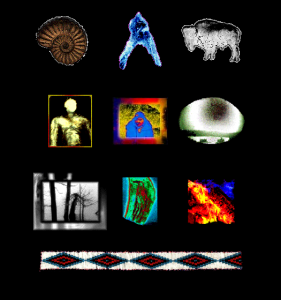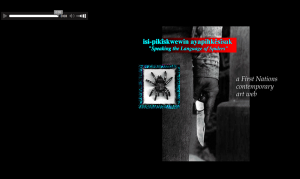Another “cheesey” title for a post by “Métis is the Medium!” I’ll keep my write up short since I created an equally cheesey video to the title to exhibit what I believe Indigenous Screen Sovereignty is. However here are some points that I illustrated through my video (some more subtle than others) that Kristen Dowel expresses:
- Reflect visions informed by my individual artistic perspective yet have these visions deeply rooted in my cultural ties to Aboriginal nations and the intertribal urban Aboriginal communities (pg. 20)
- Articulate environments as Indigenous and exhibit Indigenous experiences (pg. 14)
- Not only are the cities that both my sister and I live in Indigenous but the internet spaces we occupy are as well (gesturing to Indigenous cyberspace)
- Acknowledge territory (pg. 14)
- Stronger sense of belonging through seeing oneself reflected in the landscape (pg. 9-10)
- Not only for me but for others that can connect to this story
- Aboriginal Audience (pg. 3)
- Specifically those Indigenous people who feel like they can connect to this story
- Production process creating and strengthening Indigenous relationships (pg. 13)
- Had a few Indigenous folks help me with this project. Largely my Sister who gave me the permission to use her pictures and discussed this project with me.
(NOTE: The video is too large a file to be uploaded to wordpress so it will be emailed!)
Close Reading of Isi-pîkiskwêwin-Ayapihkêsîsak
 Ahasiw Maskegon-Iskwew exhibits screen sovereignty in Isi-pîkiskwêwin-Ayapihkêsîsak through cultural ties, Indigenous experiences and choice of primary audience. As Dowel states “the media practice of Aboriginal filmmakers in Vancouver reflects visions informed by their individual artistic perspectives yet deeply rooted in their cultural ties to Aboriginal nations and intertribal urban Aboriginal community…” (pg. 20). Though Dowel focuses on filmmakers the same can be said for Maskegon-Iskwew and his website. Maskegon-Iskwew expresses screen sovereignty through the many pages on Isi-pîkiskwêwin-Ayapihkêsîsak which depict Indigenous experiences through poetry. The page with the title “The Sanctity of Privilege” exhibits an experience within an urban area while “Leaving Town on a Saturday Night” presents a more rural experience. The collection of poetry depicting Indigenous experiences from more than one area exhibits the deeply rooted cultural ties in intertribal Aboriginal communities and Aboriginal nations. Furthermore the wampum belt at the bottom of the 9 pictures depicted to the left furthers Maskegon-Iskwew’s cultural connection to Indigenous communities.
Ahasiw Maskegon-Iskwew exhibits screen sovereignty in Isi-pîkiskwêwin-Ayapihkêsîsak through cultural ties, Indigenous experiences and choice of primary audience. As Dowel states “the media practice of Aboriginal filmmakers in Vancouver reflects visions informed by their individual artistic perspectives yet deeply rooted in their cultural ties to Aboriginal nations and intertribal urban Aboriginal community…” (pg. 20). Though Dowel focuses on filmmakers the same can be said for Maskegon-Iskwew and his website. Maskegon-Iskwew expresses screen sovereignty through the many pages on Isi-pîkiskwêwin-Ayapihkêsîsak which depict Indigenous experiences through poetry. The page with the title “The Sanctity of Privilege” exhibits an experience within an urban area while “Leaving Town on a Saturday Night” presents a more rural experience. The collection of poetry depicting Indigenous experiences from more than one area exhibits the deeply rooted cultural ties in intertribal Aboriginal communities and Aboriginal nations. Furthermore the wampum belt at the bottom of the 9 pictures depicted to the left furthers Maskegon-Iskwew’s cultural connection to Indigenous communities.
In addition, Maskegon-Iskwew strongly “represent[s] Aboriginal experiences…” (Dowel pg. 14) as illustrated in the poetry on Isi-pîkiskwêwin-Ayapihkêsîsak. As stated earlier the poetry on his website depicts experiences from many ares and many states that a being is in (spiritual, mental, physical). Spaces outside of digital areas are not the only ones being exhibited to have Indigenous presence and experience in Maskegon-Iskwew ‘s website. Instead Isi-pîkiskwêwin-Ayapihkêsîsak goes further by the use of medium in presenting these Indigenous experiences. The use of technology and the internet creates an Indigenous experience outside of geographical territory, presenting screen sovereignty both in the content being presented and the medium used for Isi-pîkiskwêwin-Ayapihkêsîsak.
It is evident that Maskegon-Iskwew ensures this website is intended for an Indigenous audience because of the artistic choices he made. When first entering Isi-pîkiskwêwin-Ayapihkêsîsak one hears a man speak in an Aboriginal language (I believe Cree) stating the title of the website. Visually, one sees the Cree writing of the title and then the English translation in a smaller font below. Furthermore on the side of the title it states “a First Nations contemporary art web” which if you didn’t get it by the title, it’s an Indigenous website! By clearly stating this is a First Nations contemporary art web Maskegon-Iskwew is exemplifying his targeted audience. By having the title only spoken in the Aboriginal language it furthers his intended primary audience to be an Aboriginal Audience. “This consideration of an Aboriginal audience for Aboriginal media also expresses screen sovereignty” (Dowel pg. 3). Therefore Maskegon-Iskwew exhibits screen sovereignty through having a primary audience be an Indigenous audience and by presenting cultural ties through exhibiting experiences of Indigenous peoples from both intertribal urban Aboriginal communities and Aboriginal nations. He also represents Indigenous experiences through content and creates and Indigenous experience by his choice in medium.
annie guerin
November 9, 2016 — 1:34 pm
I really enjoyed Danielle’s piece. I felt her title, “Screen Sovereignty with my Sister Shannon” and playful introduction nodding to the fact that a personal film of she and her sister was also created for this piece, caught my attention immediately. Although the film isn’t available on the blog itself I think this only further creates intrigue. Danielle created a narrative for effective storytelling by simply articulating she had made a story. And as Madeline Taylor showed us in her guest lecture on audio storytelling, by pausing some examples of stories before we, the audience knew how they resolved or ended, created not only a memorable story but it established a narrative. Within seconds of reading Danielle’s piece I was left wanting to know so much more, and this made Danielle’s blog very memorable. Madeline also spoke to the use of space, such as the use of layered soundscapes, to tell stories. I feel Danielle’s title alone creates a ,very powerful space that articulated her expression of visual sovereingty.